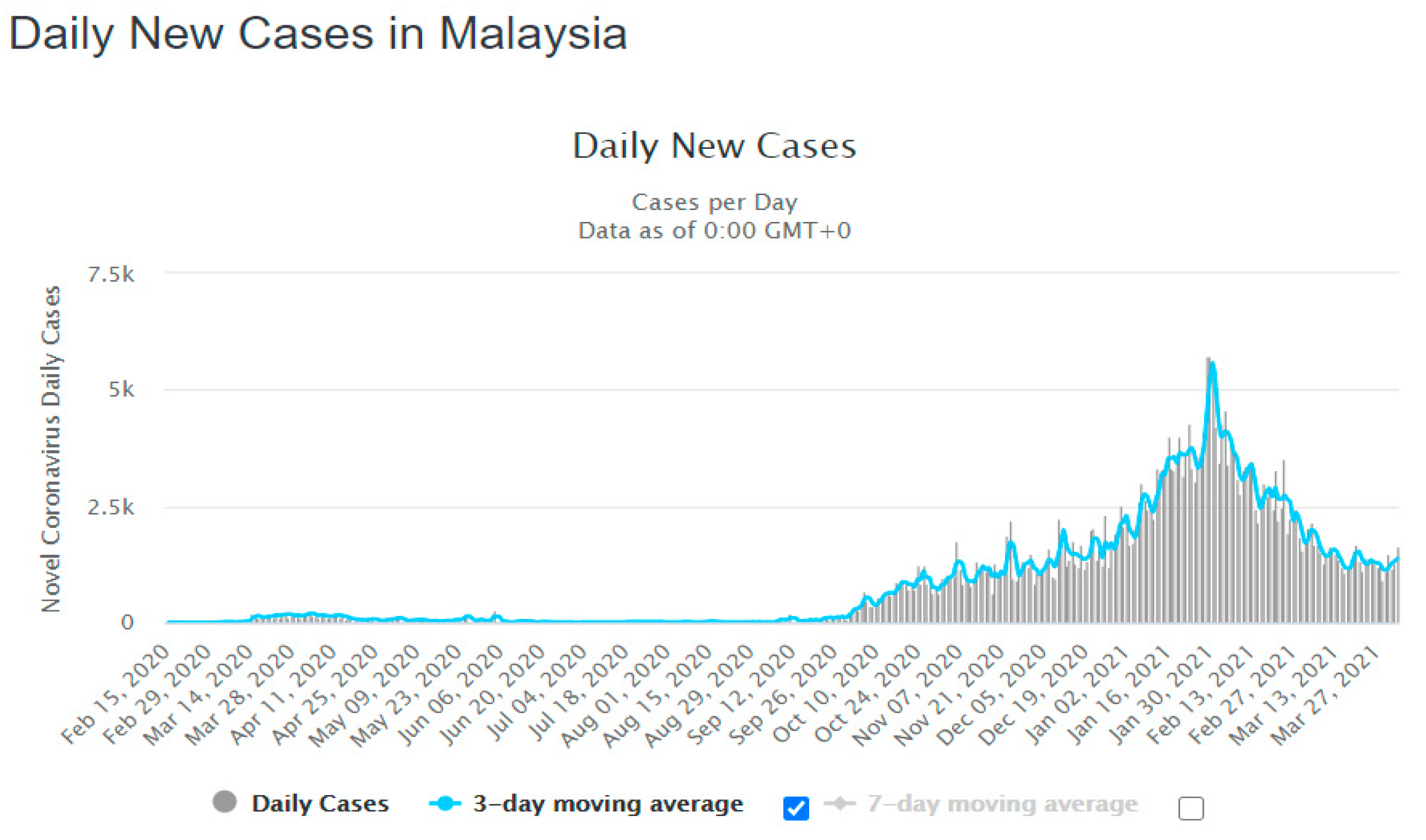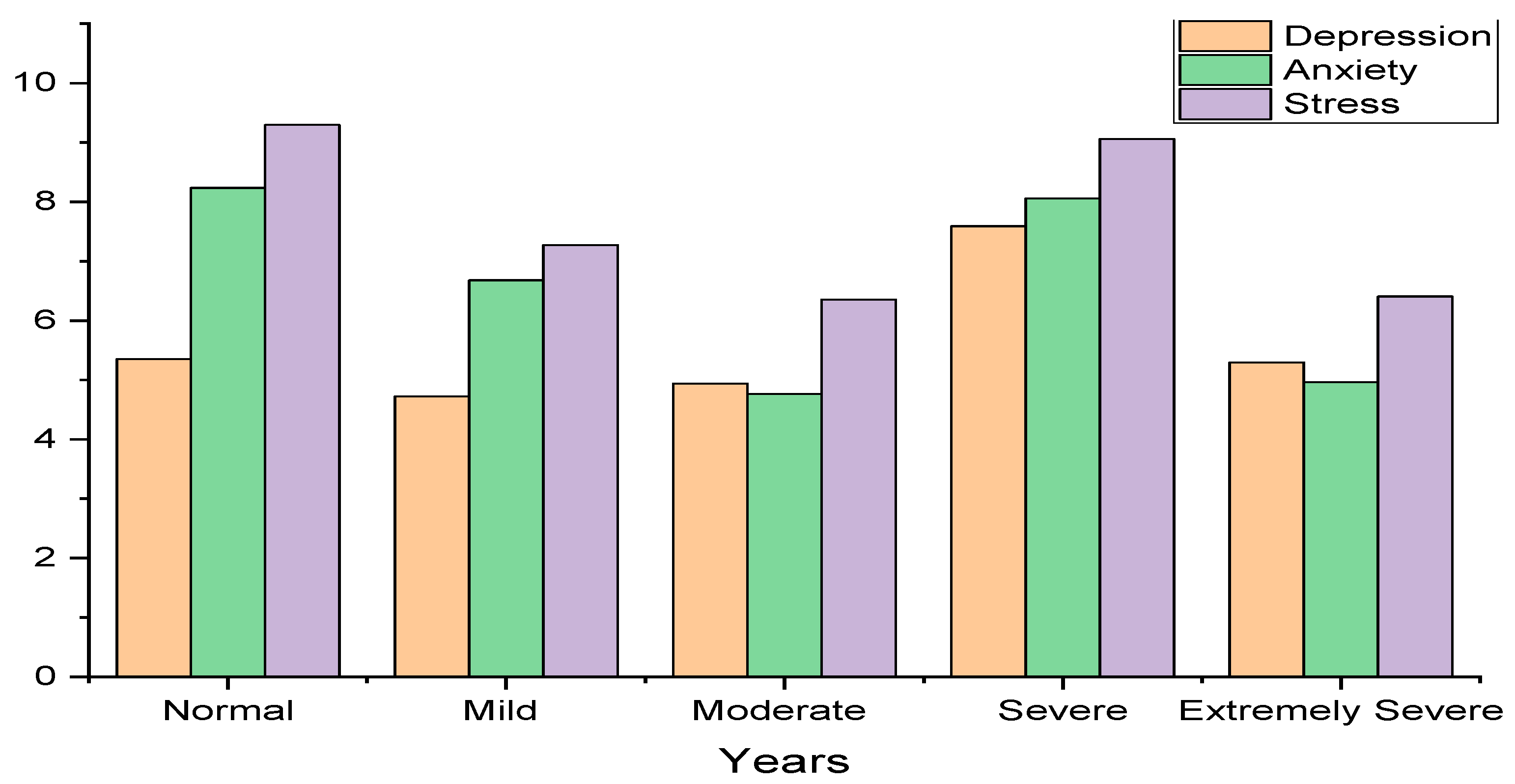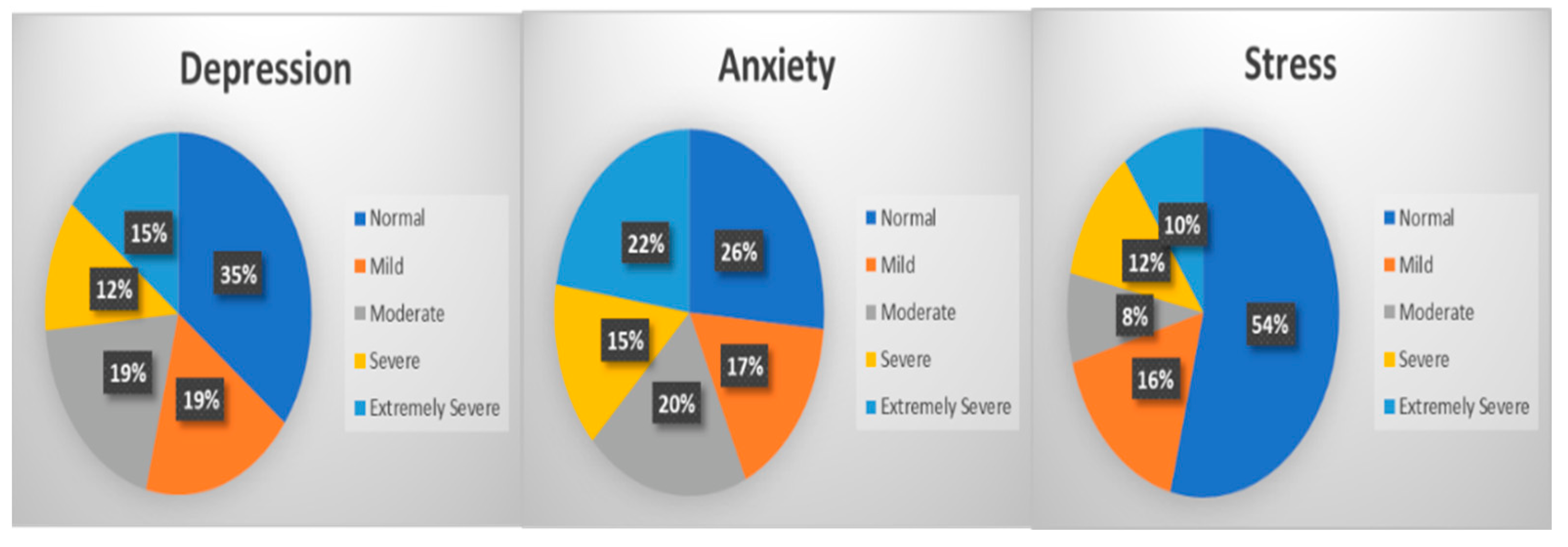Validation of “Depression, Anxiety, and Stress Scales” and “Changes in Psychological Distress during COVID-19” among University Students in Malaysia
Abstract
:1. Introduction
- RH 1: The latent variable psychological distress has a concurrent validity coefficient of 0.70 or higher, suggesting that DASS-21 has convergent validity.
- RH 2: The latent variable psychological distress has an average variance extracted (AVE) of 0.50 or higher, suggesting that DASS-21 has convergent validity.
- RH 3: The association between variables measured for depression, anxiety, and stress is less than r = 0.85, validating the discriminative validity of DASS-21.
- RH4: Correlations between the variables measured for anxiety, depression, and stress are r= 0.50 and more significant in representing nomological validity.
2. Literature Review
3. Methods and Materials
3.1. Sampling and Study Design
3.2. Research Instrument Used
3.3. Data Collection
- 0 NEVER—This did not matter to me in the slightest.
- 1 SOMETIMES—Applied to me to a degree.
- 2 OFTEN—Applied to me to a significant extent or a large portion of the time.
- 3 ALWAYS—Applied to me constantly, or at least most of the time.
3.4. Data Analysis
4. Results
4.1. CFA: Confirmative Factor Analysis of DASS-21
4.2. Descriptive Statistics
4.2.1. The Depression, Anxiety, and Stress Descriptive Statistics
4.2.2. Depression, Anxiety, and Stress during May 2020
4.2.3. Depression, Anxiety, and Stress during September 2020
5. Discussion
5.1. Model Fit
5.2. Convergent Validity
5.3. Discriminant Validity
5.4. Nomological Validity
6. Conclusions
Author Contributions
Funding
Institutional Review Board Statement
Informed Consent Statement
Data Availability Statement
Acknowledgments
Conflicts of Interest
References
- Grubic, N.; Badovinac, S.; Johri, A.M. Student mental health in the midst of the COVID-19 pandemic: A call for further research and immediate solutions. Int. J. Soc. Psychiatry 2020, 66, 517–518. [Google Scholar] [CrossRef] [PubMed]
- Seo, E.J.; Ahn, J.-A.; Hayman, L.L.; Kim, C.-J. The association between perceived stress and quality of life in university students: The parallel mediating role of depressive symptoms and health-promoting behaviors. Asian Nurs. Res. 2018, 12, 190–196. [Google Scholar] [CrossRef] [PubMed] [Green Version]
- Naji, G.M.A.; Isha, A.S.N.; Mohyaldinn, M.E.; Leka, S.; Saleem, M.S.; Rahman, S.M.N.B.S.A.; Alzoraiki, M. Impact of safety culture on safety performance; mediating role of psychosocial hazard: An integrated modelling approach. Int. J. Environ. Res. Public Health 2021, 18, 8568. [Google Scholar] [CrossRef] [PubMed]
- Papier, K.; Ahmed, F.; Lee, P.; Wiseman, J. Stress and dietary behaviour among first-year university students in Australia: Sex differences. Nutrition 2015, 31, 324–330. [Google Scholar] [CrossRef] [PubMed]
- Javaid, M.U.; Isha, A.S.N.; Ghazali, Z.; Langove, N. Psychosocial risks: Health and wellbeing of workers in petrochemical industry of Malaysia. Proceedings of 2015 International Symposium on Technology Management and Emerging Technologies (ISTMET), Langkawi, Malaysia, 25–27 August 2015; pp. 314–318. [Google Scholar]
- Saleem, M.S.; Isha, A.S.N.; Yusop, Y.M.; Awan, M.I.; Naji, G.M.A. The role of psychological capital and work engagement in enhancing construction workers’ safety behavior. Front. Public Health 2022, 10, 91. [Google Scholar] [CrossRef]
- Aktekin, M.; Karaman, T.; Senol, Y.Y.; Erdem, S.; Erengin, H.; Akaydin, M. Anxiety, depression and stressful life events among medical students: A prospective study in Antalya, Turkey. Med. Educ. 2001, 35, 12–17. [Google Scholar] [CrossRef]
- Dissing, A.S.; Jørgensen, T.B.; Gerds, T.A.; Rod, N.H.; Lund, R. High perceived stress and social interaction behaviour among young adults. A study based on objective measures of face-to-face and smartphone interactions. PLoS ONE 2019, 14, e0218429. [Google Scholar] [CrossRef]
- Naji, G.M.A.; Isha, A.S.N.; Alazzani, A.; Saleem, M.S.; Alzoraiki, M. Assessing the Mediating Role of Safety Communication Between Safety Culture and Employees Safety Performance. Front. Public Health 2022, 10, 840281. [Google Scholar] [CrossRef]
- Tarasova, A. The impact of learning using adaptive intellectual learning systems on the psychological well-being of the learner. Eur. Humanit. Stud. State Soc. 2020, 2, 96–112. [Google Scholar]
- Crum, A.J.; Jamieson, J.P.; Akinola, M. Optimizing stress: An integrated intervention for regulating stress responses. Emotion 2020, 20, 120. [Google Scholar] [CrossRef]
- Naji, G.M.A.; Isha, A.S.N.; Alazzani, A.; Brough, P.; Saleem, M.S.; Mohyaldinn, M.E.; Alzoraiki, M. Do Leadership, Organizational Communication, and Work Environment Impact Employees’ Psychosocial Hazards in the Oil and Gas Industry? Int. J. Environ. Res. Public Health 2022, 19, 4432. [Google Scholar] [CrossRef] [PubMed]
- Sundarasen, S.; Chinna, K.; Kamaludin, K.; Nurunnabi, M.; Baloch, G.M.; Khoshaim, H.B.; Hossain, S.F.A.; Sukayt, A. Psychological impact of COVID-19 and lockdown among university students in Malaysia: Implications and policy recommendations. Int. J. Environ. Res. Public Health 2020, 17, 6206. [Google Scholar] [CrossRef] [PubMed]
- Foster, J.; Hodder, S.G.; Lloyd, A.B.; Havenith, G. Individual responses to heat stress: Implications for hyperthermia and physical work capacity. Front. Physiol. 2020, 11, 1147. [Google Scholar] [CrossRef] [PubMed]
- Plotnikoff, R.C.; Costigan, S.A.; Williams, R.L.; Hutchesson, M.J.; Kennedy, S.G.; Robards, S.L.; Allen, J.; Collins, C.E.; Callister, R.; Germov, J. Effectiveness of interventions targeting physical activity, nutrition and healthy weight for university and college students: A systematic review and meta-analysis. Int. J. Behav. Nutr. Phys. Act. 2015, 12, 45. [Google Scholar] [CrossRef] [Green Version]
- Saleem, M.S.; Isha, A.S.N.; Mohd Yusop, Y.; Awan, M.I.; Naji, G.M.A. Agility and safety performance among nurses: The mediating role of mindful organizing. Nurs. Rep. 2021, 11, 666–679. [Google Scholar] [CrossRef]
- Gustems-Carnicer, J.; Calderón, C.; Calderón-Garrido, D. Stress, coping strategies and academic achievement in teacher education students. Eur. J. Teach. Educ. 2019, 42, 375–390. [Google Scholar] [CrossRef]
- Saleem, M.S.; Isha, A.S.N.; Awan, M.I.; Yusop, Y.B.; Naji, G.M.A. Fostering academic engagement in post-graduate students: Assessing the role of positive emotions, positive psychology, and stress. Front. Psychol. 2022, 13, 920395. [Google Scholar] [CrossRef]
- Saleem, M.S.; Isha, A.S.N.B.; Benson, C.; Awan, M.I.; Naji, G.M.A.; Yusop, Y.B. Analyzing the impact of psychological capital and work pressure on employee job engagement and safety behavior. Front. Public Health 2022, 10, 1086843. [Google Scholar] [CrossRef]
- Lovibond, P.F.; Lovibond, S.H. The structure of negative emotional states: Comparison of the Depression Anxiety Stress Scales (DASS) with the Beck Depression and Anxiety Inventories. Behav. Res. Ther. 1995, 33, 335–343. [Google Scholar] [CrossRef]
- Sarkar, S.; Gupta, R.; Menon, V. A systematic review of depression, anxiety, and stress among medical students in India. J. Ment. Health Hum. Behav. 2017, 22, 88. [Google Scholar]
- Haidar, S.A.; De Vries, N.; Karavetian, M.; El-Rassi, R. Stress, anxiety, and weight gain among university and college students: A systematic review. J. Acad. Nutr. Diet. 2018, 118, 261–274. [Google Scholar] [CrossRef] [PubMed]
- Geldsetzer, P. Knowledge and perceptions of COVID-19 among the general public in the United States and the United Kingdom: A cross-sectional online survey. Ann. Intern. Med. 2020, 173, 157–160. [Google Scholar] [CrossRef] [PubMed] [Green Version]
- Islam, M.A.; Barna, S.D.; Raihan, H.; Khan, M.N.A.; Hossain, M.T. Depression and anxiety among university students during the COVID-19 pandemic in Bangladesh: A web-based cross-sectional survey. PLoS ONE 2020, 15, e0238162. [Google Scholar] [CrossRef] [PubMed]
- Thawabieh, A.M.; Qaisy, L.M. Assessing stress among university students. Am. Int. J. Contemp. Res. 2012, 2, 110–116. [Google Scholar]
- Kandiah, J.; Saiki, D. Pilot Study: A Survey to Assess the Effects of Stress on Eating Habits and Appearance Behaviors of Male University Undergraduate Students. J. Acad. Nutr. Diet. 2020, 120, A28. [Google Scholar] [CrossRef]
- Hussien, T.; Hussien, S. Strategies for Coping Educational and Psychological Stress; Dar Alfiker: Amman, Jordan, 2006. [Google Scholar]
- Iedema, R.; Wodak, R. Introduction: Organizational discourses and practices. Discourse Soc. 1999, 10, 5–19. [Google Scholar] [CrossRef]
- Saleem, M.S.; Isha, A.S.N.; Yusop, Y.M.; Awan, M.I.; Naji, G.M.A. Mindfulness Research: A Bibliometric Analysis. In Innovation of Businesses, and Digitalization during Covid-19 Pandemic: Proceedings of The International Conference on Business and Technology (ICBT 2021); Springer International Publishing: Cham, Switzerland, 2022; pp. 611–632. [Google Scholar]
- Khasawneh, A.I.; Humeidan, A.A.; Alsulaiman, J.W.; Bloukh, S.; Ramadan, M.; Al-Shatanawi, T.N.; Awad, H.H.; Hijazi, W.Y.; Al-Kammash, K.R.; Obeidat, N. Medical students and COVID-19: Knowledge, attitudes, and precautionary measures. A descriptive study from Jordan. Front. Public Health 2020, 8, 253. [Google Scholar] [CrossRef]
- Ding, L.; Velicer, W.F.; Harlow, L.L. Effects of estimation methods, number of indicators per factor, and improper solutions on structural equation modeling fit indices. Struct. Equ. Model. Multidiscip. J. 1995, 2, 119–143. [Google Scholar] [CrossRef]
- Ghaleb, E.A.; Dominic, P.D.; Alzoraiki, M.; Mohamed, I.; Naji GM, A.; Ammar, A.A. The Role of Transformational Leadership Style and Intellectual Capital in Improving the Service Quality of the Public Healthcare Sector in Developing Countries–Conceptual Study. Int. J. Intellect. Hum. Resour. Manag. (IJIHRM) 2022, 3, 1–7. [Google Scholar] [CrossRef]
- Eustis, E.H.; Williston, S.K.; Morgan, L.P.; Graham, J.R.; Hayes-Skelton, S.A.; Roemer, L. Development, acceptability, and effectiveness of an acceptance-based behavioral stress/anxiety management workshop for university students. Cogn. Behav. Pract. 2017, 24, 174–186. [Google Scholar] [CrossRef]
- Wang, J.; Luo, Q.; Chen, R.; Chen, T.; Li, J. Susceptibility analysis of COVID-19 in smokers based on ACE2. Preprints 2020, 2020030078. [Google Scholar] [CrossRef] [Green Version]
- Jiang, H.; Zhou, Y.; Tang, W. Maintaining HIV care during the COVID-19 pandemic. Lancet HIV 2020, 7, e308–e309. [Google Scholar] [CrossRef] [PubMed]
- An, S.; Song, R. Effects of health coaching on behavioral modification among adults with cardiovascular risk factors: Systematic review and meta-analysis. Patient Educ. Couns. 2020, 103, 2029–2038. [Google Scholar] [CrossRef] [PubMed]
- Zvolensky, M.J.; Garey, L.; Rogers, A.H.; Schmidt, N.B.; Vujanovic, A.A.; Storch, E.A.; Buckner, J.D.; Paulus, D.J.; Alfano, C.; Smits, J.A. Psychological, addictive, and health behavior implications of the COVID-19 pandemic. Behav. Res. Ther. 2020, 134, 103715. [Google Scholar] [CrossRef]
- Tinsley, H.E.; Tinsley, D.J. Uses of factor analysis in counseling psychology research. J. Couns. Psychol. 1987, 34, 414. [Google Scholar] [CrossRef]
- Anderson, J.C.; Gerbing, D.W. Structural equation modeling in practice: A review and recommended two-step approach. Psychol. Bull. 1988, 103, 411. [Google Scholar] [CrossRef]
- Tabachnick, B.G.; Fidell, L.S.; Ullman, J.B. Using Multivariate Statistics; Pearson: Boston, MA, USA, 2007. [Google Scholar]
- Antony, M.M.; Bieling, P.J.; Cox, B.J.; Enns, M.W.; Swinson, R.P. Psychometric properties of the 42-item and 21-item versions of the Depression Anxiety Stress Scales in clinical groups and a community sample. Psychol. Assess. 1998, 10, 176. [Google Scholar] [CrossRef]
- Asghari, A.; Saed, F.; Dibajnia, P. Psychometric properties of the Depression Anxiety Stress Scales-21 (DASS-21) in a non-clinical Iranian sample. Int. J. Psychol. 2008, 2, 82–102. [Google Scholar]
- Fowler, D.; Freeman, D.; Steel, C.; Hardy, A. The catastrophic interaction hypothesis: How do stress, trauma, emotion and information processing abnormalities lead to psychosis? In Trauma and Psychosis; Routledge: Oxfordshire, UK, 2007; pp. 113–136. [Google Scholar]
- Kaplan, D. Structural Equation Modeling: Foundations and Extensions; Sage Publications: New York, NY, USA, 2008; Volume 10. [Google Scholar]
- Lee, H.; Lim, J. Kujobangjeongshik Mohyungboonsekwa AMOS 20.0 [Structural Equation Modeling With AMOS 20.0]; JypHyunJae Publishing Co.: Seoul, Republic of Korea, 2013. [Google Scholar]
- Moon, S. Kujobangjeongshikmodelingeui Yehaewa Jeokyong [Basic Concepts and Applications of Structural Equation Modeling]; Hakjisa: Seoul, Republic of Korea, 2013. [Google Scholar]
- Hu, L.T.; Bentler, P.M. Cutoff criteria for fit indexes in covariance structure analysis: Conventional criteria versus new alternatives. Struct. Equ. Model. Multidiscip. J. 1999, 6, 1–55. [Google Scholar] [CrossRef]
- Nordin, R.B.; Kaur, A.; Soni, T.; Por, L.K.; Miranda, S. Construct validity and internal consistency reliability of the Malay version of the 21-item depression anxiety stress scale (Malay-DASS-21) among male outpatient clinic attendees in Johor. J. Med. J. Malays. 2017, 72, 265. [Google Scholar]
- Lan, H.T.Q.; Long, N.T.; Van Hanh, N. Validation of depression, anxiety and stress scales (DASS-21): Immediate psychological responses of students in the e-learning environment. Int. J. High. Educ. 2020, 9, 125–133. [Google Scholar] [CrossRef]








| N = 201 | Cronbach’s Alpha (α) |
|---|---|
| Total DASS-21 | 0.976 |
| Depression | 0.959 |
| Anxiety | 0.962 |
| Stress | 0.977 |
| Measure | Values | Cut of Point | Interpretation |
|---|---|---|---|
| CMIN | 307.337 | -- | -- |
| DF | 180 | -- | -- |
| CMIN/DF | 1.707 | Between 1 and 3 | Excellent |
| CFI | 0.978 | >0.95 | Excellent |
| SRMR | 0.027 | <0.08 | Excellent |
| RMSEA | 0.059 | <0.06 | Excellent |
| Measure | N | Mean | Standard Deviation | Standard Error | Skewness | Kurtosis |
|---|---|---|---|---|---|---|
| Depression | 201 | 1.62 | 0.88 | 0.62 | 1.92 | 2.63 |
| Anxiety | 201 | 1.72 | 0.97 | 0.69 | 1.66 | 1.33 |
| Stress | 201 | 1.46 | 0.80 | 0.57 | 1.28 | 4.40 |
| Ranges | Depression | Anxiety | Stress |
|---|---|---|---|
| Normal | 0–4 | 0–3 | 0–7 |
| Mild | 5–6 | 4–5 | 8–9 |
| Moderate | 7–10 | 6–7 | 10–12 |
| Severe | 11–13 | 8–9 | 13–16 |
| Extremely Severe | 14+ | 10+ | 17+ |
| Depression | Anxiety | Stress | % Change in Depression | % Change in Anxiety | % Change in Stress | ||||
|---|---|---|---|---|---|---|---|---|---|
| Score 1st Time | Score 2nd Time | Score 1st Time | Score 2nd Time | Score 1st Time | Score 2nd Time | ||||
| Normal | 50 | 34 | 23 | 25 | 57 | 51 | −32% | 9% | −11% |
| Mild | 13 | 18 | 23 | 16 | 14 | 17 | 38% | −30% | 21% |
| Moderate | 21 | 19 | 28 | 18 | 11 | 8 | −10% | −36% | −27% |
| Severe | 7 | 11 | 8 | 15 | 9 | 11 | 57% | 88% | 22% |
| Extremely Severe | 6 | 15 | 15 | 23 | 6 | 10 | 150% | 53% | 67% |
| Sum of Average Scores | 204% | 83% | 73% | ||||||
| Research Hypothesis | If Supported |
|---|---|
| RH-1: The latent variable psychological distress has a concurrent validity coefficient of 0.70 or higher, suggesting that DASS-21 has convergent validity. | Yes |
| RH-2: The latent variable psychological distress has an average variance extracted (AVE) of 0.50 or higher, suggesting that DASS-21 has convergent validity. | Yes |
| RH3: The relationships between the variables measured for “depression, anxiety, and stress” are less than r = 0.85, validating the discriminative validity of DASS-21. | Yes |
| RH-4: Correlations between the variables measured for “depression, anxiety, and stress” are r = 0.50 or greater (nomological validity). | Yes |
Disclaimer/Publisher’s Note: The statements, opinions and data contained in all publications are solely those of the individual author(s) and contributor(s) and not of MDPI and/or the editor(s). MDPI and/or the editor(s) disclaim responsibility for any injury to people or property resulting from any ideas, methods, instructions or products referred to in the content. |
© 2023 by the authors. Licensee MDPI, Basel, Switzerland. This article is an open access article distributed under the terms and conditions of the Creative Commons Attribution (CC BY) license (https://creativecommons.org/licenses/by/4.0/).
Share and Cite
Isha, A.S.N.; Naji, G.M.A.; Saleem, M.S.; Brough, P.; Alazzani, A.; Ghaleb, E.A.A.; Muneer, A.; Alzoraiki, M. Validation of “Depression, Anxiety, and Stress Scales” and “Changes in Psychological Distress during COVID-19” among University Students in Malaysia. Sustainability 2023, 15, 4492. https://doi.org/10.3390/su15054492
Isha ASN, Naji GMA, Saleem MS, Brough P, Alazzani A, Ghaleb EAA, Muneer A, Alzoraiki M. Validation of “Depression, Anxiety, and Stress Scales” and “Changes in Psychological Distress during COVID-19” among University Students in Malaysia. Sustainability. 2023; 15(5):4492. https://doi.org/10.3390/su15054492
Chicago/Turabian StyleIsha, Ahmad Shahrul Nizam, Gehad Mohammed Ahmed Naji, Muhammad Shoaib Saleem, Paula Brough, Abdulsamad Alazzani, Ebrahim A. A. Ghaleb, Amgad Muneer, and Mohammed Alzoraiki. 2023. "Validation of “Depression, Anxiety, and Stress Scales” and “Changes in Psychological Distress during COVID-19” among University Students in Malaysia" Sustainability 15, no. 5: 4492. https://doi.org/10.3390/su15054492
APA StyleIsha, A. S. N., Naji, G. M. A., Saleem, M. S., Brough, P., Alazzani, A., Ghaleb, E. A. A., Muneer, A., & Alzoraiki, M. (2023). Validation of “Depression, Anxiety, and Stress Scales” and “Changes in Psychological Distress during COVID-19” among University Students in Malaysia. Sustainability, 15(5), 4492. https://doi.org/10.3390/su15054492







